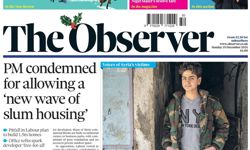The newspaper devoted the whole of last Friday’s front page to recording the names of the victims, which also ran across a further six pages inside.
To commemorate the historic milestone in the city's history, the Mail also produced a broadsheet replica edition free with the newspaper telling the story of the two worst nights of the Blitz and written in the present tense as if the bombs had just fallen silent.
Hundreds of people were killed and injured when the Luftwaffe razed the city to the ground on the nights of May 7/8 and May 8/9, 1941. Wartime censorship prevented the Mail from reporting the events. Hull was only referred to as a "north east coast town" and the full horror the city suffered and the immense bravery of its citizens went largely unreported, even though the city was the most bombed outside London.
The eight-page broadsheet, which has been designed to replicate the style of the Mail during the Second World War, is the fullest account of those terrible nights in May, 1941, the newspaper has ever published.
The Mail's acting assistant news editor Allison Coggan trawled the city archives, tracked down personal diaries and accounts from the time and interviewed survivors, who were just children at the time to produce a dramatic, historically-accurate record of the raids.
Design editor Ian Bond painstakingly created the 1940s-style broadsheet and head of photographic Jim Mitchell tracked down the names of the victims from the Civilian War Dead Roll of Honour at Westminster Abbey as well as previously unpublished photographs and historic records.
Mail Editor John Meehan said: "Our coverage is a fitting tribute to the sacrifices of the people of this region during this country’s darkest hours and also a most remarkable commemoration of those who died.
"The supplement replicates the style of the Mail during the Second World War brilliantly. The stories, written in the present tense, record the events with immense power and emotion. Even the small details reek of credibility. For example, the weather forecast above the masthead is exactly as it was at the time of the most devastating Blitz raids.
"As ever, a number of people have been involved in this but I must pay particular praise to Allison, Ian and Jim for their outstanding dedication and professionalism.
"This is the most creative, powerful, impactful and in-tune-with-the-community coverage ever produced in the Mail.
“It is also a potent statement – if one is needed – of the enduring power and impact of newspapers. No other form of media could rival what we have been able to achieve today through a 126-year-old brand that remains the most influential in this region."
The Mail's coverage has also brought plaudits from the vicar of the city's Holy Trinity Church, Rev Neil Barnes, who described the listing of the names of the civilian dead and the supplement as an "inspiration and so very poignant."
He added: "It really does bring home to us the scale of what this city went through. I am sure that for many people, it will stir memories, some painful of course. But I hope also that the fact that the city and the media are giving such prominence to it will be cathartic and healing in its own way."










